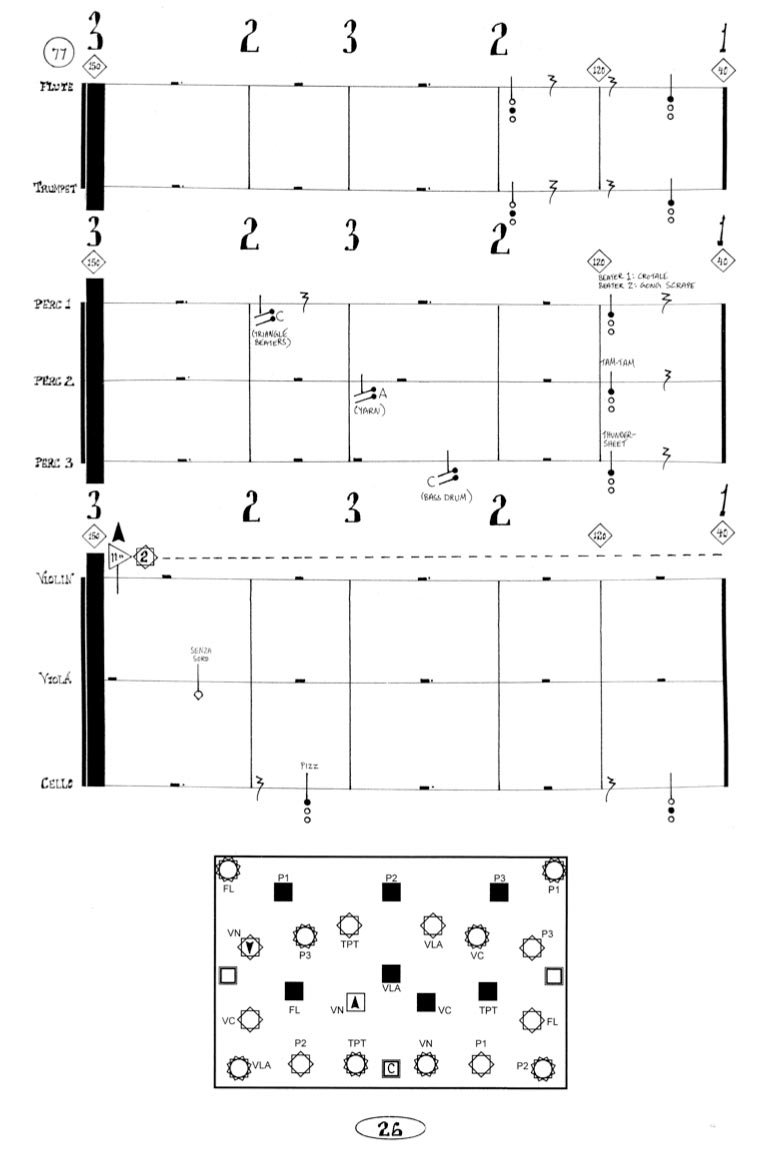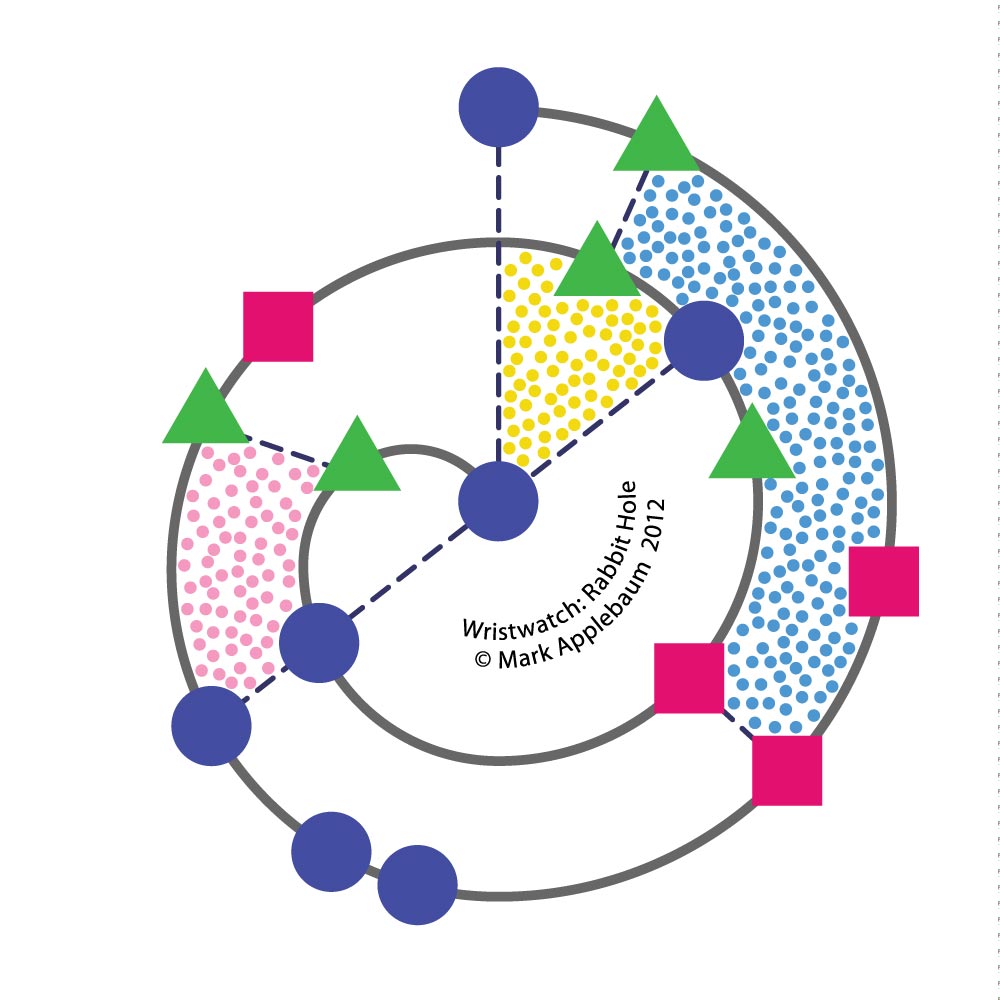Rabbit Hole (2012)

Octet of flute, trumpet, violin, viola, cello, three percussion. Commissioned by the San Francisco Contemporary Music Players / Meet the Composer.
There seem to be two kinds of musicians. The first type says, “This is what I do; write me something like that.” The second type says, “This is what I do; please (please!) challenge me to do something different.” To my mind, Steve Schick, is decidedly in the second category.
So when Steve asked me to compose for the San Francisco Contemporary Music Players I felt at liberty to pursue an astonishingly ridiculous idea I had been mulling for almost two decades: to write a piece of music based on page turns. Until Rabbit Hole the “page turn piece” was only an absurd mental musing provoked by a logistical dilemma: annoyed by the challenges of finding reasonable moments for players to turn the pages of their parts (due to my habit of composing dense, overly prolix music that keeps the arms constantly engaged) I vowed to one day compose the page turns first—the page turn as principal musical material. I would then compose the mute changes for brass instruments and the mallet changes for percussionists. Precise rhythmic moments would be identified for trading the alto flute and piccolo, for adjusting the violin bow’s tension, for oiling a trumpet valve, for picking up claves and putting them down, and so on. There would even be composed states of attentiveness: high for body language suggesting imminent sonic production; medium for tracking musical flow in a slightly relaxed state; and low to describe what the body might do during a full movement of rest. The very last thing to be determined, and only grudgingly, would be pitches and rhythms.
What was once an asinine concept has been realized as the serious—or at least fastidious—musical enterprise that is this piece. (It may still be asinine.) I recognize the seeming irrationality of a project that eschews the utility of conventional musical materials and replaces them with structures based on musical marginalia. The result may make you smile cheerfully or shake your head in exasperated disbelief, or both. But it’s not supposed to be comedic. It aspires to the absurd side of the ludic.
Exploring this particular rabbit hole appealed to me for four main reasons:
First, the piece makes virtually no sound. Increasingly I’ve become annoyed that music, for most people, seems to demand sound. Must it? Some of my recent pieces have veered away from that supposition, whether through the addition of increasingly predominant visual elements (e.g. Concerto for Florist and Orchestra, Aphasia for hand gestures synchronized to sound, Echolalia consisting of 22 Dadaist rituals, the Mouseketier sound-sculpture which functions as both an instrument and as visual art), or through the active suppression of prescribed sound in the compositional phase in order to invoke real or imagined sound in performance (e.g. Tlön for three conductors and no players, The Metaphysics of Notation—a 72-foot graphic score without instruction).
Second, the Eurocentric preoccupation with pitch as the (tediously) foremost parameter is subverted, simply sidestepped. (The players do get to play exciting, conventionally virtuosic, and highly mercurial contrapuntal passages made up of idiomatic and extended techniques with precise—and lovingly chosen—pitches. But, perversely, the players are asked to play at the impossible dynamic ppppp—a gorgeous sound, if paradoxically compressed, concentrated, and squashed.)
Third, the focus becomes a theater made up of ancillary musical praxis, the ritualistic margins of performance culture, a way to floodlight neglected edges of what Christopher Small inclusively calls musicking. (By the way, I’d hate for actors to perform this piece. This is a kind of music, however weird, for musicians—special, intrepid ones who are not insulted by an invocation to care about things that are not central to their conservatory training.)
Finally, the logistics should be eminently practical. In theory, this should be a piece that works easily. After all, the germinal impulse was to obviate difficult page turns and patronize the incidence of “extra-musical” actions.
Regrettably this is not a practical piece after all. There are 90 page turns (everyone reads from full 180-page scores in which each page has a five-second duration—but with no two pages made up of the same meter and tempo arrangements, thereby creating a deliberate choreography of conduction). Furthermore, it is preposterously swollen with events—picking up mallets, changing mutes, etc.—each at a precisely specified time. Moreover, additional categories of material crept in, ones that seem ancillary but are in fact fundamental: fussy hand gestures; frequent physical relocation; and the migration of the printed score to the forearm as players read from custom-made wristwatches (responding to various glyphs as the second hand passes over them).

There is indeed something perplexing about a piece whose counterpoint demands that the audience ask, at a given moment, “Should I pay attention to the cello’s nearly inaudible melody, or to the percussionist’s lifting of an instrument (which will not be played, by the way), or to the flutist who just started walking to another position on stage?”
And some will be inclined to ask “Is it even music?” I’m convinced that this it not the right question. The question should be: “Is it interesting?”
Increasingly I’ve pursued the things that seem intriguing to me, even when, as artistic formulations, their likeness to familiar models—those traditionally defined pieces that one is supposed to make as a composer (beyond which a judgment of dilettantism or lunacy is invited)—is tenuous. Becoming unhinged from a paradigm can be pretty interesting. Or, at the very least, it encourages a trip down a rabbit hole which, however terrifying (it may never end...there may be no return...), is rarely boring.
* * *
Rabbit Hole is affectionately dedicated, with gratitude, to Steven Schick, San Francisco Contemporary Music Players director and intrepid collaborator. It was commissioned through Meet the Composer’s Commissioning Music/USA program, which is made possible by generous support from the Mary Flagler Cary Charitable Trust, New York City Department of Cultural Affairs, the William and Flora Hewlett Foundation, and the Helen F. Whitaker Fund.
 Experimental | Why Experimental?
Experimental | Why Experimental?
Download score - Part 1 (PDF- 10MB)
Download score - Part 2 (PDF- 9MB)
Download score - Part 3 (PDF- 10MB)
The following two videos document the premiere by the San Francisco Contemporary Music Players. They demonstrate a dilemma of representation: the cinematographer’s cut—with its edits that cut from camera to camera and afford close-up views of intimate details—is probably more entertaining; but, on the downside, by presenting only the compelling choices made by the filmmakers it forsakes other concurrent events—ones that, in this piece, are silent and therefore absent from the document.
The video begins with an interview. The performance begins at 5:00.
On the other hand, the composer’s cut, with its static wide-angle view, presents the entirety of the piece and invites the viewer to consider all the events—much as our ears are entitled to consider all layers of an acoustic counterpoint; however, the downside is that its absence of close-ups loses the sense of intimacy and detail: the sought-after “entirety” presented here is illusory because minutiae is not perceivable. Sigh.